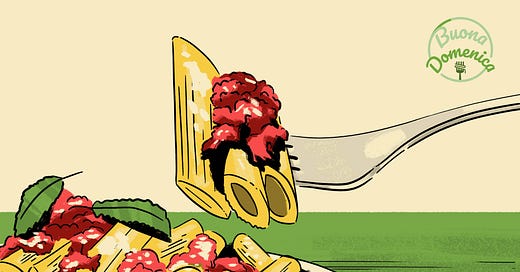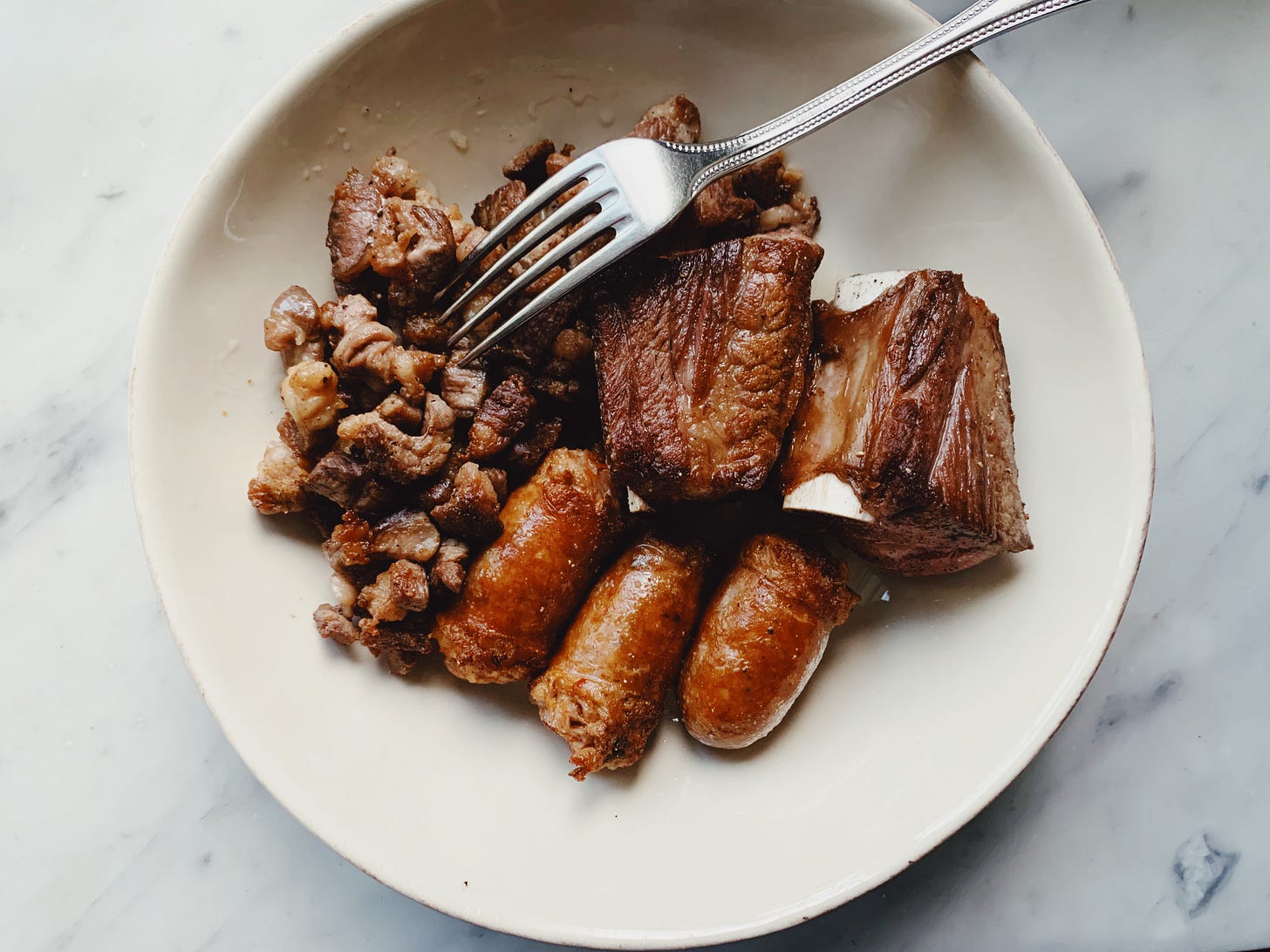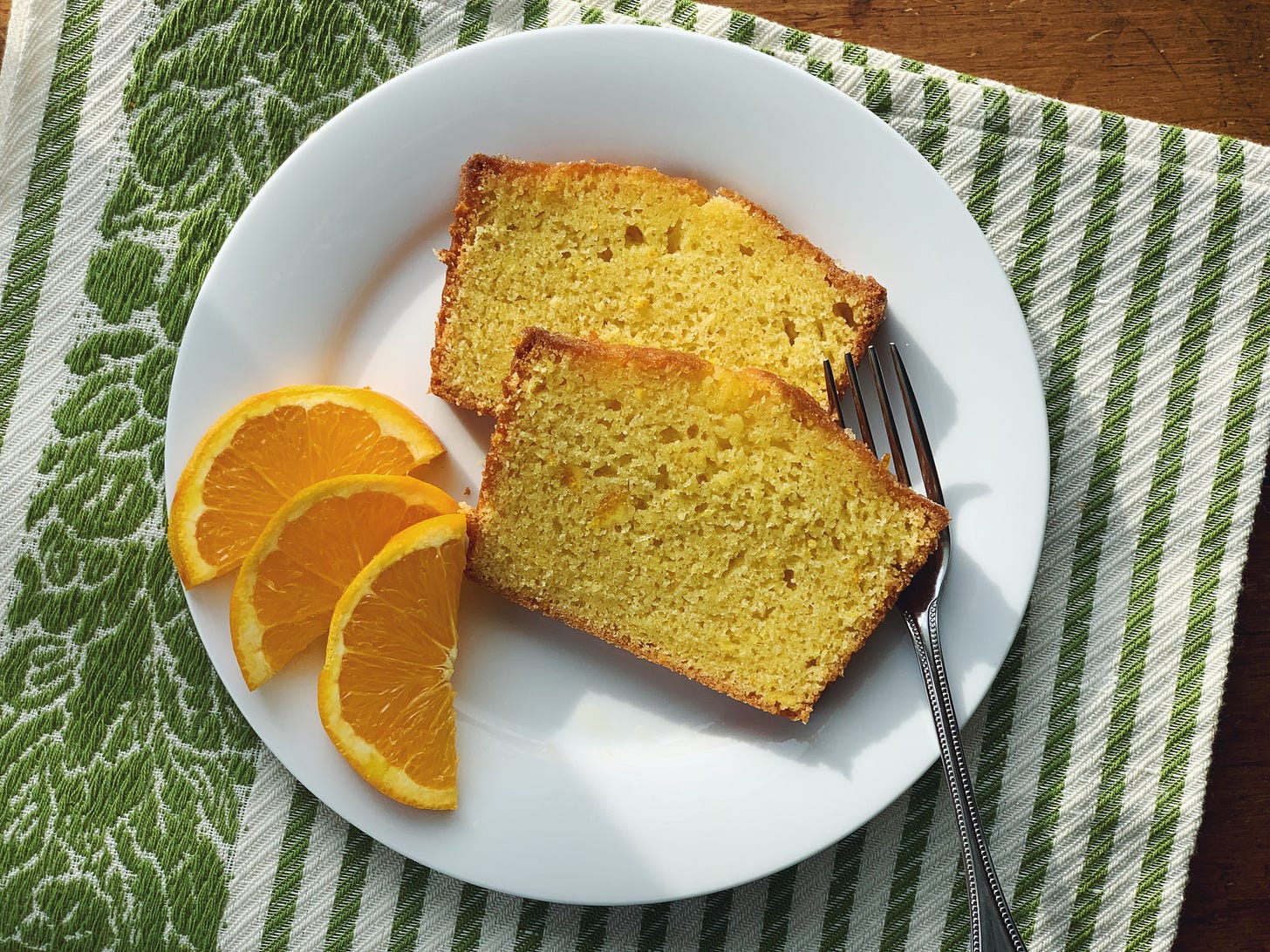
Benvenuti!
Welcome to Buona Domenica. My aim here is to provide you with a generous helping of cooking inspiration every Sunday, with a particular focus on sharing high-quality, thoroughly tested recipes—the kind that have defined my work—along with Italian food and travel stories, interviews, and more. This idea has been ping-ponging around my head for awhile and I’m happy to be finally putting it out into the world.
A quick housekeeping note: My online class offerings, information about tours and workshops, and recipe archive will continue to be housed on my website. In fact, I just posted details and registration for a new pasta class (more on that below).
Many of the recipes I share here will be ones that I dream up in my kitchen. But I also plan to mine the extensive collection of Italian cookbooks that I have accumulated over the years—old, vintage, and new. And I’ll continue to write about Italian food producers, cookbook authors, and other makers who inspire me.
It seems fitting, though, that the first recipe I share with you here on Substack should be my favorite Sunday sauce.
Preparing “un buon ragù della domenica” is a weekly ritual for millions of Italian home cooks, and probably millions of non-Italians, too. I count myself among them, and yet, a little confession: I don’t make ragù every Sunday. I feel slightly guilty about this, but not enough to change my errant ways. Sometimes I just want roast chicken, or (in warmer temps) grilled chops, or vegetable quiche and a glass of wine.
But more often than not I do want ragù and all that comes with it—the fine chopping of vegetables, the spattery browning of the meat, the hours of simmering, the pooling fat, the tomato-splashed stove top, the perfume, the ritual.
Just typing those words sends me into a Sunday reverie (in my mind I’m standing at the stove inhaling the perfume of a ragù that has been bubbling gently for two hours) and now I’ve gotten ahead of myself. Let me back up a bit. You may be wondering what makes a sauce a ragù? I wrote about this a few years ago for the Washington Post. But the TL;DR version is that ragù is a range of slow-cooked meat* sauces typically paired with pasta. The term ragù, and the dish, both evolved from French ragoût, a slow-cooked stew of meat and/or vegetables that made its way to Italy along with the diminutive but grabby General Napoleon. It wasn’t until decades later that stew and pasta were united in the same bowl. The spelling change occurred during the Fascist era, when many “foreign” words were officially Italianized; ragoût became ragù.
* While true ragù is a meat-based sauce, there are good vegetarian versions that IMO qualify, including this one of mine with porcini mushrooms, and this lentil ‘Bolognese’ from my friend Lora (please don’t @ me, purists).
There are many iterations of ragù in Italian cooking, but broadly speaking, they can be divided into two (predictable) styles: Northern and Southern. Northern-style ragùs are ground or minced meat sauces (beef, pork, even duck) which use tomatoes sparingly, sometimes not at all. The queen of northern-style ragùs is, of course, ragù alla Bolognese, the luxurious, almost spoonable ground meat sauce enriched with milk or cream and tossed with egg tagliatelle or employed to make lasagne.
Southern-style ragù is a robust tomato-based sauce in which large cuts of meat are braised. Neapolitan-style ragù, for example, is typically made with large pieces of beef or pork, or a mix, and served with short, sturdy pasta. The meat is usually removed after cooking and served as a second course.
Ragù from Abruzzo, which is what I’m sharing here (because it’s my favorite and because it’s from my ancestral region), leans more toward Neapolitan style, but lamb (shoulder or leg) is often part of the mix—not surprising in this mountainous region where sheep farming is still a way of life. What the lamb contributes is a gentle sweetness, which echoes that of the tomatoes. A couple of bay leaves tossed in add their own lovely, savory perfume.
Once, this type of ragù would have been made with tough, lesser cuts of meat as a way of not letting them go to waste. When I make it, I sometimes find myself asking the butcher or meat cutter at my local market to slice off an 8-ounce piece of chuck roast or pork shoulder, which sort of defeats the purpose and makes me feel bad for asking them to carve up a beautiful roast. I’ve found a couple of ways around this: I buy the larger cuts and then divide them and put extras in the freezer; or I use beef short ribs, pork ribs, sausages, lamb shoulder chops and such, which work beautifully. With these cuts, I get the bonus of flavor from the bones and spices from the sausages.
When I made this recipe last week, I ended up using lamb from the freezer; specifically, trimmings left over from a piece of shoulder that my husband had cut up to make arrosticini (Abruzzese-style skewers) a few months ago. The trimmings were small pieces, and I thought they might end up as tough, intrusive little bits in the sauce. But the opposite happened; they became extra-tender, almost—but not quite—dissolving into the tomatoes.
My point is this: make this ragù in the spirit it was intended, with inexpensive cuts (but not poor quality!—see ‘Tips for Making Great Ragù’ below for more on this), with trimmings from your freezer, with what you have on hand, with what you like. There’s plenty of room for adaptation.
The traditional pasta to serve with this ragù is spaghetti alla chitarra, Abruzzo’s signature square-cut noodle made using a wooden frame strung with wires. The Abruzzesi also serve ragù with potato gnocchi (a heavenly combination). And, in deep winter, they make “polenta alla spianatoia” the heartiest of dishes in which you pour a pot of hot polenta out onto a (clean) table or wooden board and then spoon the ragù, along with the braised meat, on top. Everyone stakes out their territory and a most communal meal ensues.
But look, you don’t have to make homemade pasta, or gnocchi, or ruin your dining room table by pouring polenta down the center. Packaged pasta works just as well. Three of my favorite brands are Rustichella d’Abruzzo, La Molisana, and Faella. Use spaghetti—both Rustichella and La Molisana produce a square-cut chitarra noodle—or a short sturdy shape like penne.
TIPS FOR MAKING GREAT RAGÙ
1. Use a heavy-bottomed pot such as enameled cast-iron so the ragù can cook slowly without scorching.
2. Choose the best ingredients you can afford. Ragù generally calls for tougher, less expensive cuts of meat, but that shouldn’t mean poor quality; well-marbled heritage pork will yield a more flavorful sauce than leaner mass-produced pork, whose texture leans toward sawdust with long cooking. In an Abruzzese-style ragù, tomatoes are almost as important as the meat. Look for canned tomatoes in their own juice rather than heavy puree, or bottled passata that tastes bright and fresh rather than cooked or dull. I use unseasoned canned tomatoes so that I can choose which herbs and spices to add.
3. Browning adds flavor to your ragù. Season the meat; then brown over medium-high heat to create a good sear. Don’t crowd the pot (brown in batches) and give the pieces a few minutes before turning with tongs so that they lift up easily from the bottom of the pot without tearing.
4. Most ragù recipes call for sautéing aromatic vegetables—a soffrito. Chop these finely and uniformly, preferably by hand (a food processor tends to shred vegetables, which can prevent them from cooking evenly).
5. De-glaze the pan with a good-quality, inexpensive wine and allow it to bubble off, leaving a pleasant acidity.
6. Watch how your ragù changes as it cooks. The vegetables will soften and sweeten and eventually become one with the sauce. Tomatoes will mellow, and their color will deepen to terracotta. The meat will give up its fat to further enrich the sauce and improve its texture—another reason why good-quality meat matters.
RECIPE: RAGU ABRUZZESE
Makes about 1 1/2 quarts, but can be doubled if you want to make a lot and freeze some for later.
INGREDIENTS
3 tablespoons sunflower (or vegetable) oil
8 ounces (227 g) meaty beef short ribs (2 to 3), or boneless beef chuck roast, cut into 3 or 4 large pieces
8 ounces (227 g) boneless lamb shoulder, cut into bite-size pieces
8 ounces (227 g) pork sausages (2 links), each cut crosswise into 2 or 3 pieces
Fine sea salt and freshly ground black pepper
2 tablespoons extra-virgin olive oil
1 medium carrot, finely chopped
1 stalk celery, finely chopped
1 medium yellow onion, finely chopped
1 peperoncino, minced; or a pinch of crushed red pepper flakes
1/2 cup (120 ml) dry white wine
2 (24-ounce/680 g) bottles tomato passata, or 2 (28-ounce/790 g) cans whole tomatoes, passed through a food mill
2 bay leaves
INSTRUCTIONS
1. Warm the vegetable oil in a large Dutch oven or other heavy-bottomed pot over medium heat. Season the pieces of beef with a little salt and pepper and add them to the pot. Brown for 3 to 4 minutes, until nicely seared; then turn to brown the other side, another 3 to 4 minutes. Transfer them to a deep plate or bowl. Brown the sausages in the same way, turning them until nicely colored. Transfer them to the plate. Scatter the pieces of lamb in the pot and sprinkle with salt and pepper. Brown them for about 5 minutes total, stirring every so often for even browning. Transfer them to the plate with the rest of the meat.
2. Turn the heat to medium-low and add the extra-virgin olive oil to the pot if needed—if your pieces of meat are well-marbled, you may have enough rendered fat in the pot. Stir in the carrot, celery, and onion, and cook, stirring, for 8 to 10 minutes, or until the vegetables are shiny and softened. Add the peperoncino and cook for another minute or so. Pour in the wine, raise the heat to medium-high, and let it bubble briefly. Pour in the tomatoes. Return all the meat to the pot and add the bay leaves. Lower the heat to medium-low or low to maintain a gentle simmer. Cover partially and let the ragù cook, stirring it and turning the larger pieces of meat over now and then, for about 3 hours, or until the meat is very tender and the sauce is thick and velvety. Check from time to time and add a little water if the sauce thickens too much before the meat is done. Taste and adjust the seasoning with salt and pepper.
3. Remove the meat from the sauce and set it aside to serve as a second course; or, shred/chop it up and return it to the pot for a heartier ragù.
That’s it—that’s my favorite ragù. I’d love to know yours, whether it’s your nonna’s recipe or one you started making on your own. Are you northern-style or southern-style? Please share in the comments section.
And now for something sweet…
I’ve been playing around with orange cakes lately, it being citrus season. And I really like this one from Sicily. It’s called pan d’arancio, and it’s notable because you grind up an entire raw orange, peel and all, and mix it into the batter. You might think the cake would turn out bitter, or overpowering. But no; it’s fragrant, sweet, and tender, the perfect snacking cake or a nice finish to your Sunday dinner. Get the recipe.
Upcoming Classes on Zoom
I’ve added a new class to the pasta roster: Laminated Pasta Workshop, in which we will make beautiful noodles with herbs embedded in the dough. There are 10 spots in this class. The date is Saturday, March 5, 1 - 3 p.m. EST (10 a.m. Pacific). You can find out more and register here.
There are still a few spots left in the Feb. 26 Homemade Cannoli Workshop. Learn how to make this most iconic Sicilian pastry from scratch.
More classes are coming soon, so stay tuned.
PICTURE ITALY: Cilento (Campania)
Borgo La Pietraia, set in the hills above Cilento, south of Sorrento, is the setting for Food Writers in Cilento, a spring food writing workshop I’m co-hosting with Kathy Gunst and Danielle Oteri. Spaces are filling up, but we have a couple of spots left. You can find out more here.
As always, thank you for reading and subscribing.
Alla prossima,
Domenica
Special thanks to illustrator Daniela Bracco.












I love citrus anything!
I'm so happy I subscribed to your newsletter! It definitely has the vibe and the warmth of a buona domenica!